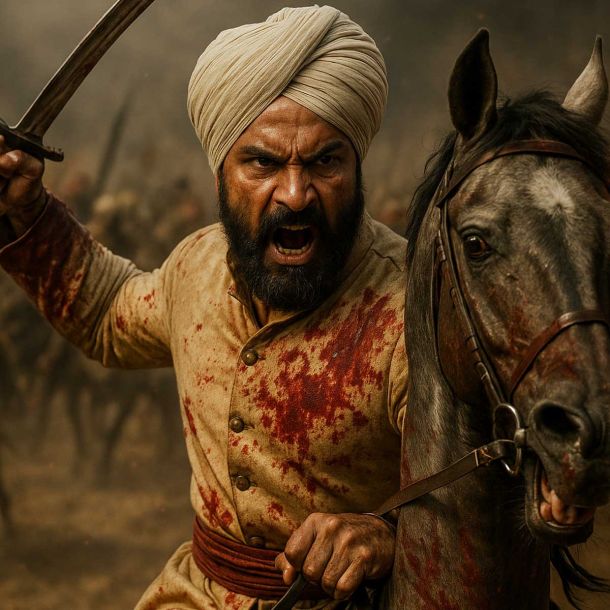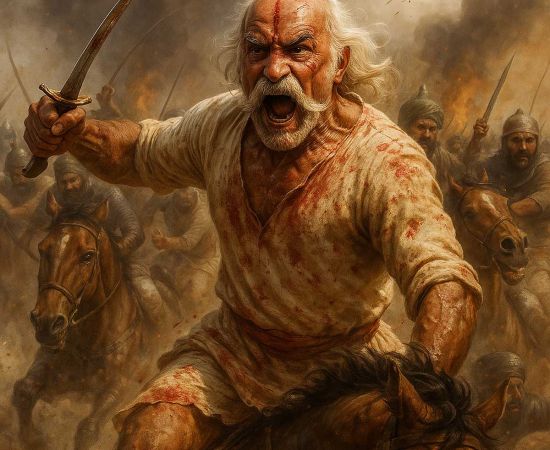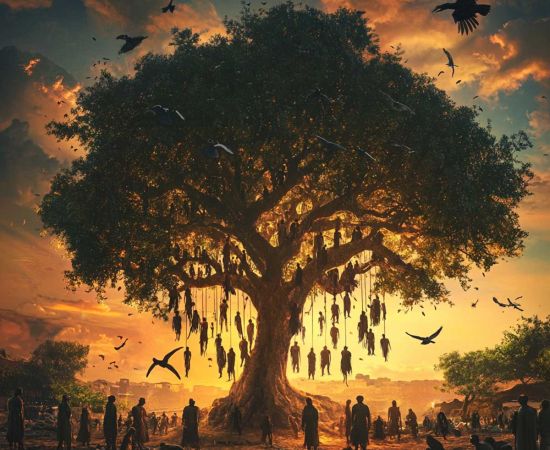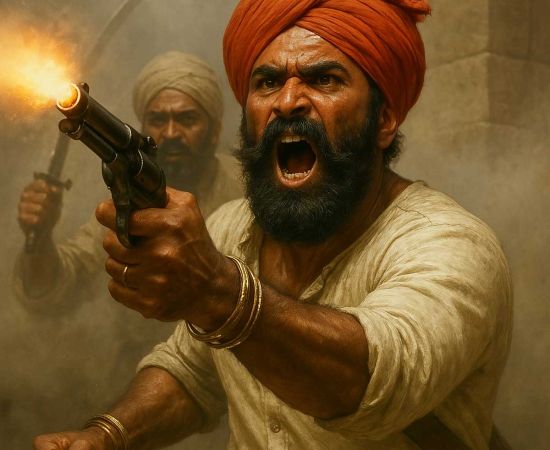MORE COVERAGE
Twitter Coverage
Satyaagrah
Written on
Satyaagrah
Written on
Satyaagrah
Written on
Satyaagrah
Written on
Satyaagrah
Written on
JOIN SATYAAGRAH SOCIAL MEDIA
"Whispers of death": In October 1990, 26 months before Karseva, Bangladeshi media spread a rumor that the disputed Babri structure had been demolished in India. The aftermath? 3,500 temples razed, and 2,400 Hindu women brutally raped
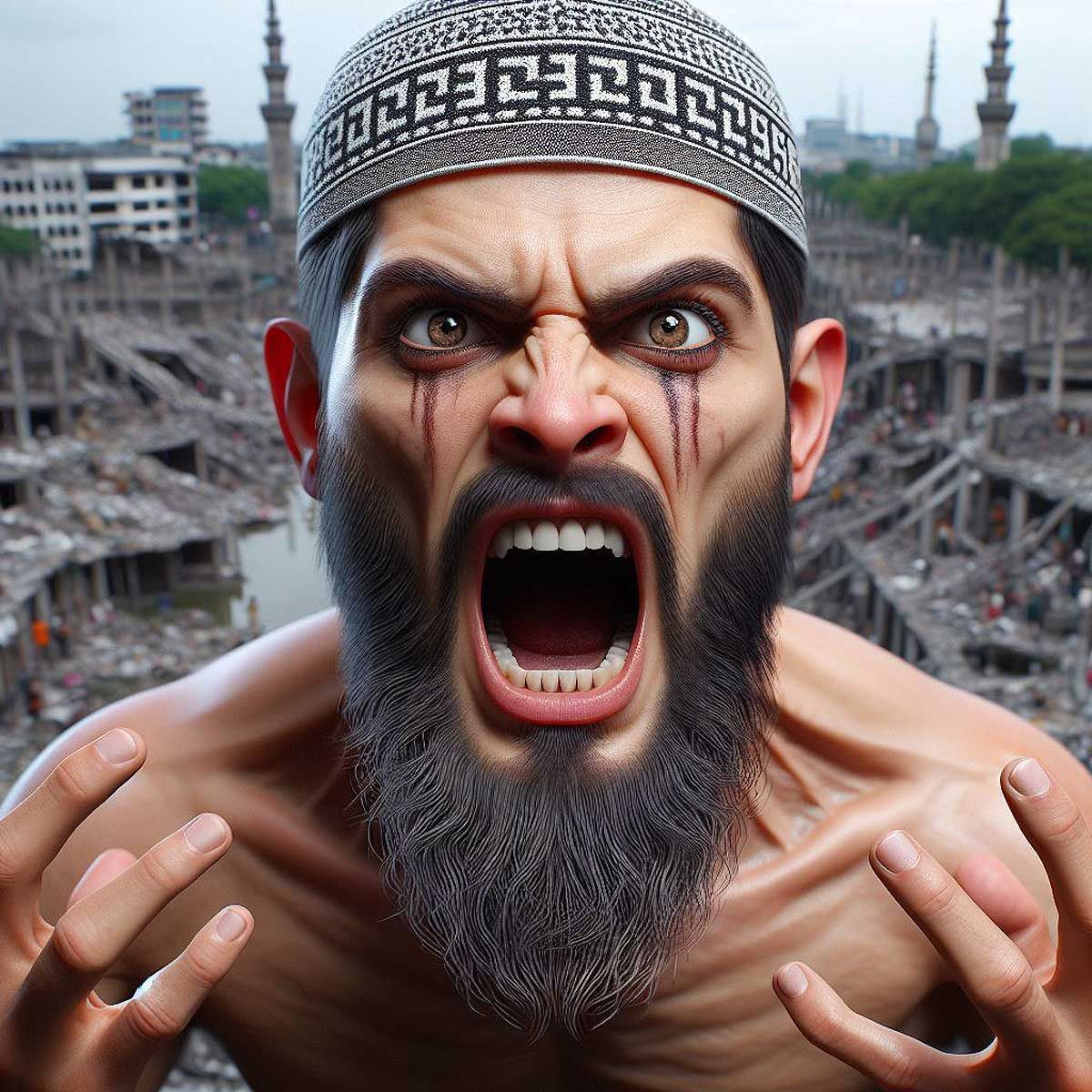
In the pages of history, December 6, 1992, stands as a pivotal moment marked by Hindu organizations as 'Shaurya Diwas.' However, amidst the commemorations, an anti-Hindu narrative attempts to overshadow the significance of this day, portraying it as an act of destroying another faith's place of worship. Let's delve into the intricacies of this historical episode and uncover the truth.
|
On this date, a contentious structure became the focal point of a heated debate – a structure that was not only a symbol of religious significance but also a source of deep-rooted tension. The disputed structure in question had its origins in the history of the Ram Temple, a sacred site for Hindus. Contrary to popular belief, this structure was not a product of harmonious coexistence. Instead, it emerged from the ashes of the demolished Ram Temple, which had been razed by Islamic invaders in times long past.
While the leftist-liberal narrative focuses on the events of December 6, 1992, it conveniently forgets to shed light on the struggles faced by Hindus in Bangladesh during the same period. A struggle that was centered around the aspiration for the reconstruction of the Ram Temple. This pivotal detail is often overlooked as the anti-Hindu ecosystem attempts to shape a narrative that places the blame squarely on one community.
Amidst the debates and commemorations, it is essential to revisit the historical context and acknowledge the multifaceted aspects surrounding the events of that fateful day. Understanding the complexities allows us to grasp the gravity of the situation and challenges the singular narrative that seeks to overshadow the nuanced history behind 'Shaurya Diwas.'
As the echoes of the struggle for the Ram Temple reverberated across India, a sinister undercurrent of violence had already begun to surge in Bangladesh. Long before the actual demolition of the disputed Babri structure, mere rumors of this event had set off a chain reaction of aggression against Hindus in Bangladesh.
|
The quest for the Ram Temple was not a recent endeavor; it had endured for five centuries. Hindus sought justice through judicial channels, adhering to the established rules and regulations. However, the Islamist crowd, driven by a different agenda, showed no inclination to follow the same principles.
On November 2, 1989, a symbolic moment marked the laying of the first stone for the Ram Temple at the disputed site. This seemingly innocuous event, however, sent shockwaves through the social fabric of Bangladesh. The news acted as a catalyst, sparking violence that targeted the Hindu community. The struggle for a sacred symbol in India was mirrored by a tragic tale of religious animosity in Bangladesh.
It becomes imperative to recognize that the events in India were not isolated; they resonated globally, influencing the dynamics of neighboring countries. The unrest in Bangladesh serves as a somber reminder of how actions in one region can have far-reaching consequences, impacting communities beyond borders. The intertwined narratives of the Ram Temple struggle and the ensuing violence in Bangladesh paint a complex picture that demands a nuanced understanding.
In the intricate tapestry of events leading up to the demolition, a significant chapter unfolded in October 1990, a staggering 26 months before the actual incident. During this time, a potent rumor circulated through the media in Bangladesh, claiming that the disputed Babri structure in India had already been demolished.
The role of the media in shaping public opinion cannot be overstated. In Bangladesh, media outlets played a pivotal role in disseminating information, sometimes blurring the lines between fact and fiction. To comprehend the atmosphere in Bangladesh during this period, it is essential to rewind to 1988 when President Hussain Muhammad Ershad, in a dictatorial regime, declared Islam as the official religion of Bangladesh.
The backdrop of political decisions and media influence sets the stage for a crucial moment on October 30, 1990. On this day, President Ershad addressed a youth conference at 'Bang Bhawan.' In his address, he assured that, as long as he held power, there would be no violence against minorities. This declaration unfolded against a backdrop of uncertainty and heightened tensions, providing a glimpse into the intricate web of political dynamics and promises that would later play a role in the unfolding events surrounding the Babri structure. Understanding these nuances is crucial to unraveling the complex tapestry of history that led to the fateful day in December 1992.
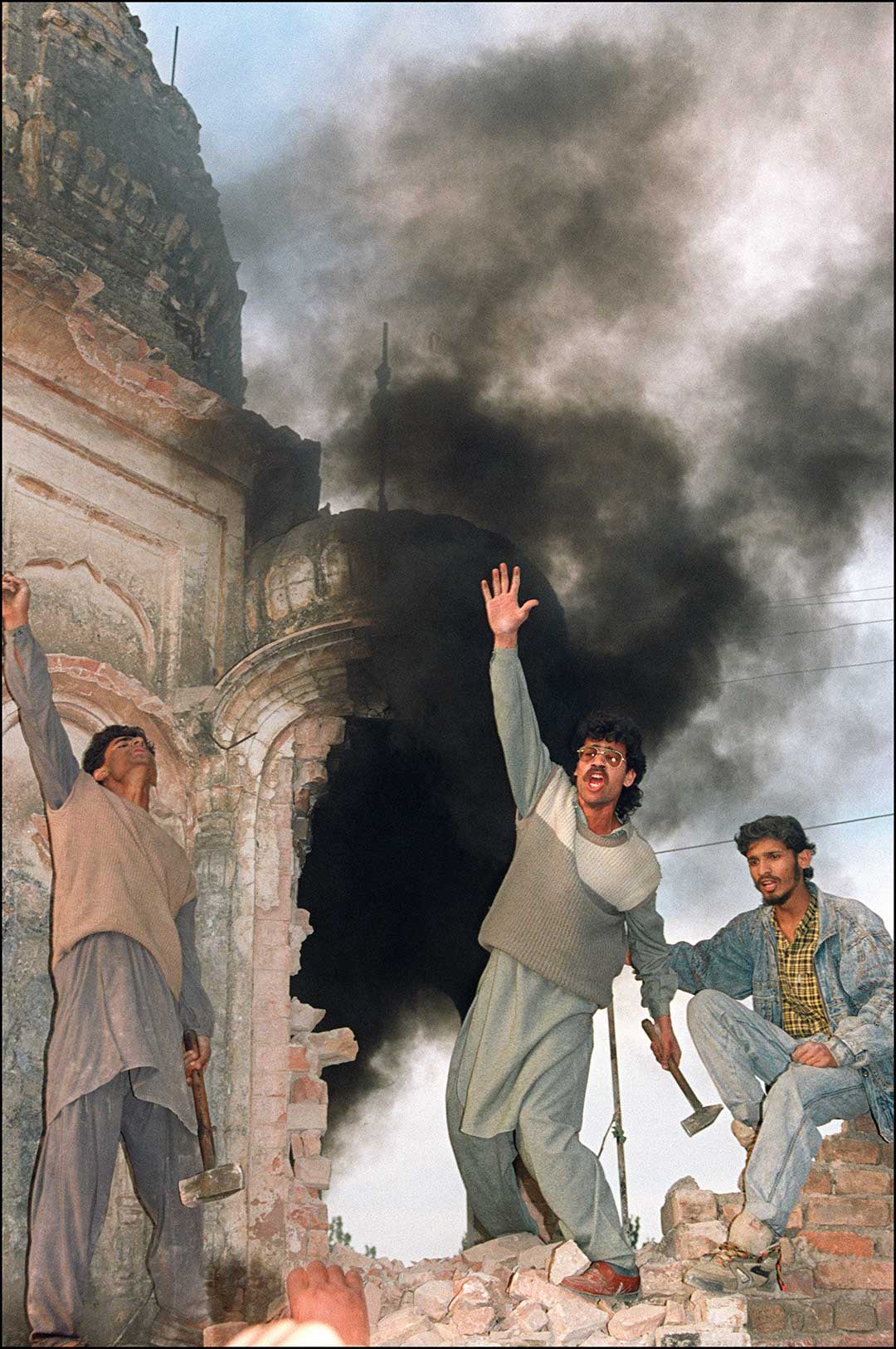 |
| Scores of Hindu temples were immediately destroyed in Pakistan and Hindus were lynched indiscriminately. | gettyimages.in |
Simultaneously, as political assurances were made, a stark reality unfolded on the ground. A mob of fundamentalist Muslims embarked on a rampage, targeting Hindu shops in a wave of violence. Among their primary targets was Gauri Math, located to the south of 'Bang Bhawan,' a mere few kilometers away from President Ershad's program.
The gravity of the situation escalated as properties owned by Hindus were set ablaze, creating an atmosphere of fear and turmoil. Shockingly, this violence unfolded in close proximity to the very authorities responsible for maintaining law and order – the police administration.
The 'Human Rights Congress for Bangladesh Minorities' (HRCBM) later documented these horrifying events in a comprehensive report. According to the report, the violence against Hindus during 1989-90 couldn't be labeled as a riot in the conventional sense, as it was orchestrated by a single party, reminiscent of the events in 1964.
The report explicitly points out that the then-ruling parties played an active role in these atrocities. Notably, in 1992, Jamaat-e-Islami, an ally of the ruling party BNP (Bangladesh Nationalist Party), found itself involved in the violence. This revelation underscores the intricate political entanglements that fueled the unrest, casting a shadow over the commitment to protecting minority communities in Bangladesh.
|
The gravity of the situation becomes starkly apparent when delving into the findings of the report. In the harrowing period of 1989-90 alone, over a thousand women fell victim to brutal acts of rape. The report paints a distressing picture of the widespread destruction, detailing the demolition of hundreds of temples and the looting and arson of houses belonging to Hindu minorities.
The night of December 6, 1992, unfolded as a dark chapter in Chittagong, where terror descended upon the Hindu community. Tragically, three innocent children met a horrifying end as they were burnt alive in Qutubdia. The shockwaves of this horrific event rippled through the nation, triggering violence that subsequently engulfed the capital, Dhaka, and other parts of the country.
In the aftermath of the turmoil, the Hindu, Buddhist, Christian Unity Council (HBCUC) undertook a critical mission to assess the ground reality. Their comprehensive report laid bare the extent of the devastation – a staggering 28,000 houses, 3,500 temples or religious institutions, and 2,500 commercial establishments owned by Hindus were either damaged or completely demolished. The scale of this tragedy underscores the urgent need to confront the atrocities faced by the Hindu community, shedding light on the widespread destruction that marred the path to religious coexistence in Bangladesh.
|
The aftermath of the violence in Bangladesh reveals a heartbreaking reality. Shankhari Bazaar in Old Dhaka, once bustling with Hindu-owned shops, now stands deserted. Shockingly, not a single Hindu shop remains, underscoring the systematic targeting and destruction of businesses owned by the Hindu community.
The mistreatment of minorities in Sylhet district echoes through the corridors of time, leaving scars that future generations may struggle to forget. Taufeed Ahmed, the then Member of Parliament from Bhola, and Narul Islam Nahid, Secretary of the All Party Alliance, contested the reported figures, asserting that the documented atrocities were likely an underestimation. This troubling revelation implies that the horrors unleashed upon the Hindu community were potentially more extensive than initially accounted for.
The brutality extended beyond economic ruin, reaching the very fabric of human dignity. Women bore the brunt of the violence, enduring not only gang rape but also a degrading form of public humiliation – being forced to walk naked on the streets. This unspeakable violation of personal integrity adds another layer of horror to an already tragic chapter in the history of communal relations.
Confronting these grim details is a somber acknowledgment of the pain endured by the Hindu community in Bangladesh. It is a collective responsibility to recognize the magnitude of the atrocities and work towards fostering a society that values the dignity, safety, and coexistence of all its members.
The horrors inflicted upon the Hindu community in Bangladesh reached a chilling low as reports surfaced of the rape of underage girls, some as young as 5 years old. The innocence of these young souls was brutally shattered in a wave of violence that spared no age group. In certain villages, the scale of the atrocities was so appalling that no woman, ranging from 5 to 70 years old, was left untouched by the cruelty unleashed upon them.
|
The assault on cultural and religious symbols further deepened the wounds. Taslima Nasreen, in her novel 'Lajja,' vividly recounts the shocking events of 1992, highlighting the attack on the Dhakeshwari temple. This sacred place of worship bore the brunt of the violence, with the main temple set ablaze, leaving behind a charred and desecrated site.
The 'Natmandir,' a structure dedicated to the entertainment of Gods and Goddesses, faced a similar fate, being engulfed in the flames of destruction. The spiritual and cultural heritage encapsulated in these sacred sites was not spared, adding a profound layer of sorrow to the already tragic tale of communal violence.
The wave of violence spared no sacred space as Madhav Gudiya Math met its demise, succumbing to the destructive forces that ravaged many religious sites. The Jayakali temple, too, stood defenseless, becoming a casualty in the wake of this relentless destruction. The premises of Brahmo Samaj, an emblem of cultural and intellectual heritage, witnessed utter devastation as everything within its bounds was systematically annihilated.
|
The Shoni Akhara temple in Demra became a target for looters, adding to the scenes of chaos that unfolded in Brihabhadra and Loki Bazaar. The extent of the havoc was immeasurable, with shops along Islampur Road, specializing in umbrellas and jewelry, falling prey to the pillaging mob. In a coordinated attack, 300 assailants descended upon 25 houses, leaving a trail of destruction in their wake. The cultural landscape of these areas was further marred as the names of many Hindu shops were replaced with Urdu names, erasing not just physical structures but also cultural identities.
Renowned writer Taslima Nasreen, in her work 'Lajja,' immortalizes the pain of these events. She recounts the heartbreaking demolition of 'Moro Chand,' a sweet shop located on Nobabpur Road. The Maa Kali temple in Rayer Bazar did not escape the wrath either, as her statue was callously broken and discarded on the ground. These incidents, vividly captured in literature, serve as a testament to the profound loss experienced by the Hindu community in the wake of the relentless destruction of their cultural and religious heritage.
The Battali temple in Thathri Bazaar, a place of worship and solace for many, fell victim to the relentless wave of destruction, becoming a haunting symbol of the violence that gripped the region. The once-hallowed grounds were not only destroyed but also ruthlessly looted, stripping away the sanctity that these temples held for the community.
|
Nobabpur, a hub of commerce and cultural exchange, bore witness to the pillaging of iconic shops like 'Kamdhon Poshari' and 'Shukla Mishthan Bhandar.' The very fabric of economic stability was torn asunder, with the looting of a factory belonging to Jatin & Company, further adding to the economic devastation.
Ratan Shankar Bazaar, nestled along Sodorghat Road, met a similar fate, succumbing to the chaos that unfolded. The temple of Nag Devta, a symbol of spiritual devotion, was not spared either, reduced to nothing more than dust in the aftermath of the violence. Taslima Nasreen, in her poignant work, emphasizes that these were not mere riots – in a riot, both sides engage in conflict. However, what unfolded was a one-sided onslaught, leaving a trail of destruction and despair in its wake.
In the face of these atrocities, a stark reality emerges – the oppression inflicted by one community upon another community. Strangely, amidst the ongoing discussions and debates surrounding the Babri demolition, there is a conspicuous silence regarding the destruction and torment faced by the Hindu community in Bangladesh during 1989-92. The question begs itself: Why is the havoc wrought by the Islamic mob on Hindus not receiving the attention it deserves?
|
The silence becomes more poignant when we cast a light on specific instances of devastation. The Durga Temple, a symbol of spiritual solace on Lalbagh Road, met a tragic end, becoming a casualty of the violence that swept through the region. Similarly, the Girigovardhan Jeetu Temple on Pushparaj Saha Lane, the Raghunath Jiu Akhara on Harnath Ghosh Lane, and the Kamrangichar Crematorium on Lalbagh – all fell victim to the ruthless destruction in 1990.
"Thousands of Muslims marched towards the Indian Embassy," marks a painful divergence from the historical ties between Bangladesh and India. It's a poignant moment to reflect on the shared history, considering that the same India had played a pivotal role in the independence of Bangladesh.
Amidst this tumultuous time, the very heart of cultural and religious identity, Sutrapur, witnessed the demolition of 14 temples. These sacred places, which had stood as symbols of spiritual reverence, crumbled in the face of the upheaval. Furthermore, the city bore witness to the brutal stabbing of 17 Hindus in Beltoli Lane, underscoring the human toll exacted by the violence. These incidents, against the backdrop of shared history and independence, reveal the intricate layers of emotions that unfolded during this tumultuous period.
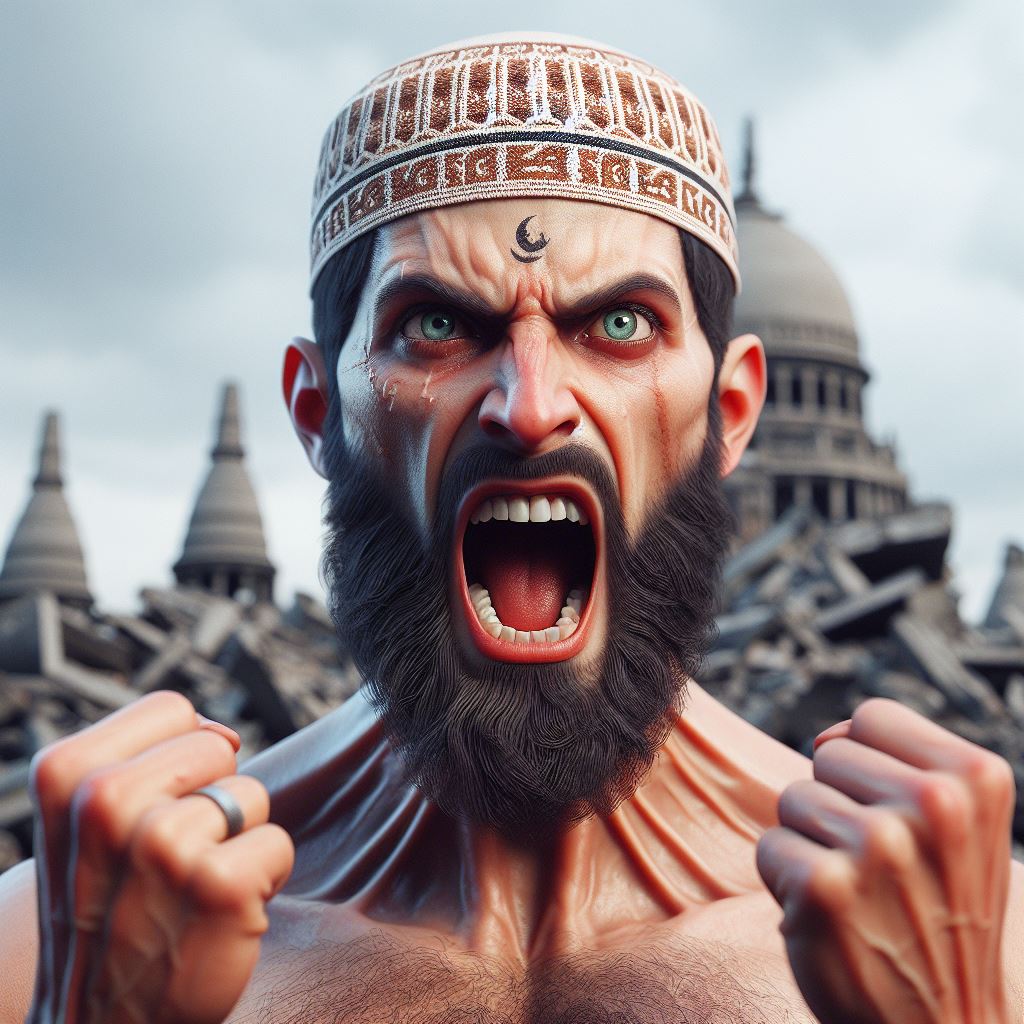 |
 Support Us
Support Us
Satyagraha was born from the heart of our land, with an undying aim to unveil the true essence of Bharat. It seeks to illuminate the hidden tales of our valiant freedom fighters and the rich chronicles that haven't yet sung their complete melody in the mainstream.
While platforms like NDTV and 'The Wire' effortlessly garner funds under the banner of safeguarding democracy, we at Satyagraha walk a different path. Our strength and resonance come from you. In this journey to weave a stronger Bharat, every little contribution amplifies our voice. Let's come together, contribute as you can, and champion the true spirit of our nation.
 |  |  |
| ICICI Bank of Satyaagrah | Razorpay Bank of Satyaagrah | PayPal Bank of Satyaagrah - For International Payments |
If all above doesn't work, then try the LINK below:
Please share the article on other platforms
DISCLAIMER: The author is solely responsible for the views expressed in this article. The author carries the responsibility for citing and/or licensing of images utilized within the text. The website also frequently uses non-commercial images for representational purposes only in line with the article. We are not responsible for the authenticity of such images. If some images have a copyright issue, we request the person/entity to contact us at satyaagrahindia@gmail.com and we will take the necessary actions to resolve the issue.
Related Articles
- Despite immense sacrifice by Hindu community in the liberation war they are subjugated denominations in the country. Bangladesh seized 26 lakh acres of land from Hindus under black law of “Enemy Property Act”
- "मेरा मुल्क, मेरा देश, मेरा ये वतन": In Tanti Bazar, Bangladesh, Mohammed Hridoy, and Mohammed Jibon attacked a Durga Puja mandap with a petrol bomb, stabbing devotees when stopped, as Bijoy Shah clarified the attack and robbery were separate incidents
- Muslim-owned restaurant's Hotel Manager Manzoor Ahmed despite clear instructions served beef to Hindu customers Supan Pal and his 12 friends celebrating a birthday party, arrested: Bangladesh
- RTI activist Anil Ochavar was murdered on Sunday night in Maharashtra’s Yavatmal, Danish Shaikh Israel and three others were arrested on the basis of a complaint filed by the victim’s wife
- Shaikh Abrar Shaikh Jamil alias Shahrukh was taken into custody after 31 swords and a khukri was recovered by the police, had ordered massive quantities of swords and khukris online using a fake ID: Aurangabad, Maharashtra
- Tension gripped Baghpat after a Hindu boy Sandeep Dudhiya was brutally attacked by his Muslim friend Muhammad Feroze, who slit his throat with a sharp knife: The boy is battling for his life
- "ठाएं ठाएं": Sarfaraz & Talib, the ruthless killers of Hindu man Ram Gopal Mishra during the blood-soaked Bahraich Durga Puja violence gunned down by police while desperately fleeing to Nepal; now both lie in hospital, awaiting the full weight of justice
- Pro-Pakistani and a Pro-Khalistani Canadian MP Jagmeet Singh is busy whitewashing anti-Hindu attacks committed by Muslim mobs during Ram Navami procession: Urges Canada to intervene to restore Human Rights
- Owaisi bole toh 'Peace', Narsinghanand bole toh 'hate speech': Owaisi played the victim and filed a complaint, leading to an FIR against ‘Dharma Sansad’
- Instagram influencers insist that 'Hindus should be identified, raped and killed openly’: Audio clip of Sabnam and her friend Nadeem abusing Hindus goes viral on social media platforms
- 23 Jan to 29 Jan - 2022 - Hindus under attack: Bulletin roundup of persecution, discrimination, and hate crimes against Hindus
- Sri Ram Shobha Yatra attacked with stone-pelting in Mulbagal town of Kolar district in Karnataka, Sri Ram idol pelted, Cars and motorcycles ransacked by the miscreants, motorcycle set ablaze: After Karauli, Hindus come under another attack
- ‘Casteless Hindu’ is Not a Paradox. It is The keystone of ‘Ghar Wapsi’ and Hindutva
- No evidence to tie Dinesh Yadav to violence, intention assumed based on him being Hindu: Anti-Hindu riots by Muslim community that shook the capital city of India and analysis of the conviction
- Ramzan Ali led Muslim mob brutally attacked two Hindu youths, Jatin and Pankaj, and dumped them in the gutter - Jatin dead – Delhi
